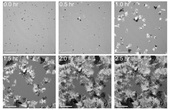Highlight
Fast Formation of Poly-Crystalline Silicon Through Nano-Crystal Seeding
Achievement/Results
In the scientific community, it is now widely agreed upon that the world will need to develop by 2050 the capability to generate 15 terawatt of power from carbon-free sources, the equivalent of 15,000 nuclear reactors, if the rise of the atmospheric carbon-dioxide level should be limited to 550ppm, twice the preindustrial level. This daunting task will likely require deploying a broad mix of carbon-free sources of power, among which solar-to-electric energy conversion (photovoltaics) is expected to play a major role.
Currently, 90% of all solar cells are based on silicon, which is abundant, stable, and environmentally benign. However, electricity from silicon solar cells is still by a factor ~20 more expensive than electricity from burning coal. Thin films of poly-crystalline silicon are seen as an attractive route to combine the efficiency of crystalline silicon cells with the cost-advantage of thin film technology.
Solid phase crystallization of hydrogenated amorphous (non-crystalline) silicon, also known as recrystallization, has been studied extensively as a route to produce poly-crystalline silicon. In this method, amorphous silicon is deposited at high rate and then turned into poly-crystalline silicon through extended heating to 600 degree Celsius. It has been observed that the recrystallization mechanism proceeds in two phases: an initial incubation period, during which small crystalline nuclei form, and a subsequent phase of crystal grain growth, which leads to the formation of a fully crystallized film. Both the incubation and crystal growth phase require about 50% of the time needed for the full crystalization of the films
IGERT trainee Curtis Anderson has developed an approach in which the recrystallization process is significantly sped up by including silicon nanocrystal “seeds” into the amorphous silicon film. The inclusion of the seed crystals almost entirely eliminates the incubation phase. Accordingly, seeded films reach full crystallization twice as fast as unseeded films.
His method relies on the “co-deposition” of Si nanoparticles into an amorphous silicon film. He now studies the effects of the initial density and diameter of the embedded particles in an effort to enhance the final grain size of the films, which is important for the films’ electronic quality. Curtis’s finding may have the potential to significantly reduce the manufacturing time of poly-crystalline silicon solar cells, which may reduce the cost of these devices. Curtis’s finding may have the potential to significantly reduce the manufacturing time of poly-crystalline silicon solar cells, which may reduce the cost of these devices.
Address Goals
Primary goal:
The achievement directly results from research at the frontier of solar energy research. It may have significant impact on the development of efficient, less expensive solar cells.
Secondary goal:
This research was achieved by an IGERT trainee working with an interdisciplinary group of other IGERT trainees involved in solar energy research. This effort of our IGERT makes a significant contribution to producing US Ph.D. graduates who are well prepared to involve themselves in renewable energy research in academia or industry.






